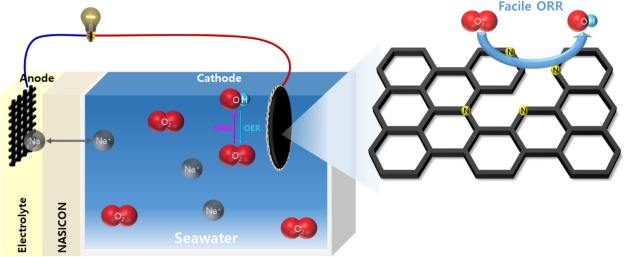Abstract
Seawater batteries represent the next generation of energy storage devices, capable of efficiently storing and discharging electricity derived from seawater. Key to their commercialization is the advancement of cost-effective catalyst materials, a challenge successfully addressed by researchers at UNIST.
Professor Dong Woog Lee and his team in the School of Energy and Chemical Engineering at UNIST have developed a high-performance catalyst for seawater batteries by integrating urea with wood waste. This innovative catalyst reduces the overvoltage required for seawater cells and accelerates the electrochemical reactions, facilitating quick electricity discharge.
Traditionally, precious metals like platinum have served as catalysts; however, these materials are prohibitively expensive.
The catalyst developed by Professor Lee's research team leverages affordable lignin and urea. Lignin, a by-product comprising 15 to 35% of wood, is generated during the production of paper and biofuels. Urea, a substance abundant in industrial wastewater, is rich in nitrogen.
 Figure 1. Graphitic illustration of a seawater battery and a schematic of the catalyst developed in this study.
Figure 1. Graphitic illustration of a seawater battery and a schematic of the catalyst developed in this study.
By heating lignin to 800°C while simultaneously reacting it with urea at the same temperature, the research team succeeded in nitrogen doping every part of the lignin structure, thereby creating a high-performance catalyst. This nitrogen incorporation significantly reduces the energy required for electricity discharge while substituting specific carbon atoms in the lignin matrix.
In performance tests conducted with the newly developed catalyst applied to the electrodes of seawater cells, results showed that its performance was comparable to that of traditional platinum catalysts. Notably, the overvoltage was lower than that of platinum (Pt/C) catalysts. A lower overvoltage translates to a higher proportion of chargeable energy that can be effectively utilized during discharge. The maximum power density achieved was 15.76 mW/cm², closely approaching that of the platinum catalyst, which measured 16.15 mW/cm²-a crucial indicator of discharge speed.
Professor Lee remarked, "We have proposed a carbon-neutral approach that not only replaces expensive precious metal catalysts but also maximizes the value of biomass and industrial waste. This innovative catalyst could be applied in various energy storage systems, including metal-air batteries."
The research was supported by the Basic Science Research Program and the Nano & Material Technology Development Program through the National Research Foundation of Korea (NRF) grant funded by the Ministry of Science and ICT (MSIT). Noteworthy contributions were made by Ji Hwan Hong and Inwoo Song in the School of Energy and Chemical Engineering at UNIST, who served as first authors on the study.
Their findings have been published in the February 2025 issue of Chemical Engineering Journal.
Journal Reference
Ji Hwan Hong, Inwoo Song, Yoonjong Cho, et al., "N-doped carbonized lignin for electrocatalysts in seawater batteries," J. Chem. Eng., (2025).






